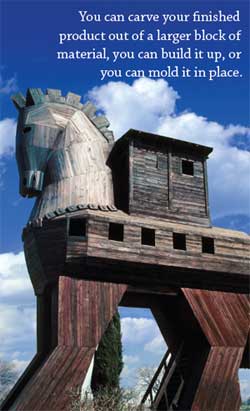By Brad Cleveland, Protomold
Three Ways to Make a Horse
 I’ve heard attributed to various sculptors—Michaelangelo more than others—the suggestion that the way to make a statue of a horse is to start with a block of marble and chisel away everything that isn’t a horse. Several years ago, at The Minneapolis Institute of Art, there was a larger-than-life sculpture of a horse. It was assembled, improbably enough, of garage sale junk: old garden tools, toasters, golf clubs, and the like, but if you relaxed your eyes it was definitely a horse. And years ago, I can remember buying one of my kids a souvenir somewhere, a cast-on-the-spot plastic horse, which, for a fistful of quarters, was injection molded before your eyes and delivered, warm but solid, to a hopper on the front of the machine.
I’ve heard attributed to various sculptors—Michaelangelo more than others—the suggestion that the way to make a statue of a horse is to start with a block of marble and chisel away everything that isn’t a horse. Several years ago, at The Minneapolis Institute of Art, there was a larger-than-life sculpture of a horse. It was assembled, improbably enough, of garage sale junk: old garden tools, toasters, golf clubs, and the like, but if you relaxed your eyes it was definitely a horse. And years ago, I can remember buying one of my kids a souvenir somewhere, a cast-on-the-spot plastic horse, which, for a fistful of quarters, was injection molded before your eyes and delivered, warm but solid, to a hopper on the front of the machine.
The reason I mention all these horses is that they represent all the ways I know of making a prototype in plastic (or in most any other material for that matter). You can carve your finished product out of a larger block of material, you can build it up, or you can mold it in place. Obviously each of these processes has its advantages, or it would have long ceased to exist, so in these series of articles, we’re going to discuss process.
Artists have their own reasons for choosing their media and methods, but for industrial designers, there are three significant concerns in the production of a prototype: quality, delivery, and cost. I list them in that order because that is the order in which the engineers we polled ranked the importance of the three variables. I’m guessing that for production, they might have ordered them differently, but prototyping has its own priorities. In this issue we will discuss each of these variables in some detail.
As will be mentioned elsewhere, Protomold (which, as you know, does rapid injection molding) now has a sister division. First Cut Prototype produces fast, high quality prototypes by direct CNC machining parts from solid stock. Together, the two make up Proto Labs Inc. In order to keep up with all of this change, we’ve expanded the scope of The Journal to address our newly expanded operations.
Together, Protomold and First Cut Prototype account for two of the three prototyping processes I mentioned: cutting and molding. But there are important offerings of a third type: building up or additive processes. These include stereolithography, 3D printing, selective laser sintering (SLS), and fused deposition modeling (FDM). We will discuss these along with our own processes in the following articles.
| Cut, Mold, or Build | |
| Part I | Three Ways to Make a Horse |
| Part II | Comparative Strength and Finish |
| Part III | Comparative Speed |
| Part IV | Comparative Cost |
About the Author
| Brad Cleveland, President and CEO Protomold The Protomold Company, Inc. 1757 Halgren Rd. Maple Plain, MN 55359 – USAPhone: 763 479 3680 Fax: 763 479 2679 E-mail: info@protomold.com |
Brad Cleveland has been the president and CEO of The Protomold Company, Inc. since November of 2001. Prior to Protomold he was cofounder and vice president of AeroMet Corporation, a laser additive manufacturing company and subsidiary of MTS Systems Corporation.Protomold®, a Proto Labs service, is the world’s fastest source for custom injection molded parts. The company fills a unique niche in the manufacturing of plastic parts, using a combination of advanced, proprietary software and sophisticated equipment to produce prototype and low volume runs of custom injection molded parts. The material properties of Protomold’s real molded parts surpass those of parts produced by additive prototyping processes. At the same time, delivery is faster and costs are lower than those associated with traditional injection molding. |
The views, opinions and technical analyses presented here are those of the author or advertiser, and are not necessarily those of ULProspector.com or UL Solutions. The appearance of this content in the UL Prospector Knowledge Center does not constitute an endorsement by UL Solutions or its affiliates.
All content is subject to copyright and may not be reproduced without prior authorization from UL Solutions or the content author.
The content has been made available for informational and educational purposes only. While the editors of this site may verify the accuracy of its content from time to time, we assume no responsibility for errors made by the author, editorial staff or any other contributor.
UL Solutions does not make any representations or warranties with respect to the accuracy, applicability, fitness or completeness of the content. UL Solutions does not warrant the performance, effectiveness or applicability of sites listed or linked to in any content.


